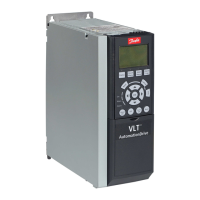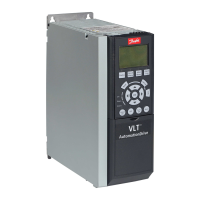FC 300 Design Guide
Introduction to FC 300
Optimization of the process regulator
The basic settings h ave now been made; al l that needs to be done is to optimize the proportional
gain, the integration time, and the differentiation time (par. 7-33, 7-34, 7-35). In most
processes, this can be done by following the guidelines given below.
1. Start the motor
2. Set par. 7-33 (Proportional Gain) to 0.3 and increase it until the feedback signal again
begins to vary continuously. Then reduce the value until the feedback signal has
stabilized. Now lower the proportional gain by 40-60%.
3. Set par. 7-34 (Integral Time) to 20 sec. and reduce the value until the feedback signal
again begins to vary continuously. Increase the inte gration time until the feedback
signal stabilize s, followed by an increase of 15-50%.
4. Only use par. 7 -35 for very fast-acting systems (differentiation time). The typical value is f
our times
the set integ ral time. The differentiator should only be used when the setting of the proportional
gain and the integral tim e has bee n fully optimized. Make sure that oscillations in t h e fee db ack
signal are sufficiently damped by the low-pass filter on the feedback signal.
NOTE
If necessary, start/stop can be activated a number of times in order to p rovoke
a variation of the feedback signal.
" Ziegler Nichols Tuning Method
In order to tune the PID controls of the adjustable frequency drive, several tuning methods can be used.
One approach is to use a technique which was developed in the 1950s but w hich has stood the test of
time and is still used today. This method is known as the Zie
gler Nichols tuning.
NOTE
The method described must not be u sed on app lications that could be damaged by the
oscillations created by marginally stable control settings.
The criteria for adjusting the parameters are
based on evaluating the system at the limit of
stability rather than on taking a step response.
We incre ase the p roportional gain (K
u
) until we
observe continuous oscillations (P
u
) (as measured
on the feedback), that is, until the system
becomes marginally stable. The corresponding
gain (called the ultimate gain) an
d the period of
oscillation (also called the ultimate perio d) are
determined as show n in Figure 1.
Figure 1: Marginally stable system
P
u
should be meas
ured when the amplitude of oscillation is quite sma l l. Then we "back
off " from this gain again, as shown in Table 1.
K
u
is the gain at which the oscillation is obtained.
39
MG.33.B6.22 - VLT is a registered Danfoss trademark

